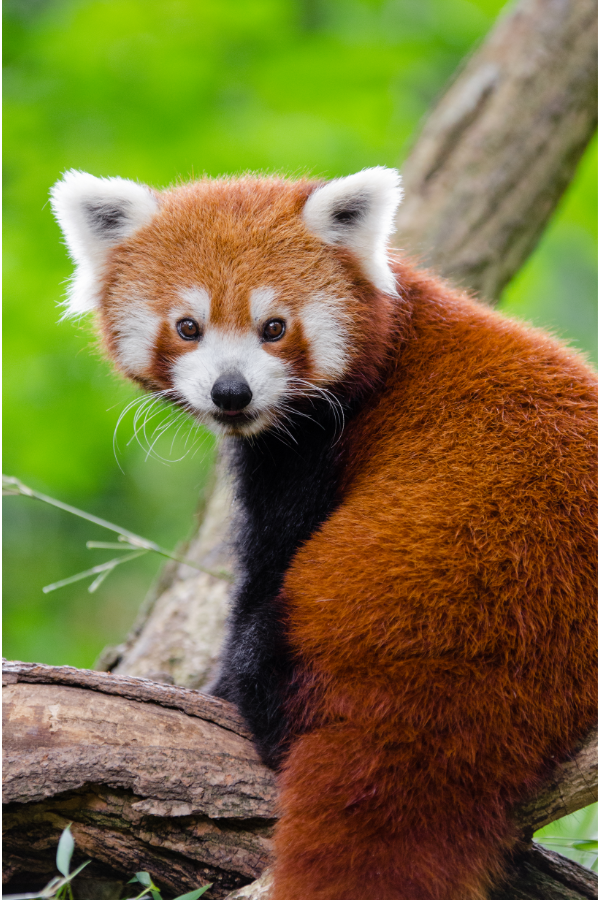Top Red Panda Facts For Kids
Do you want to learn more about red pandas? These adorable creatures are unique, and there is a lot to learn about them.
In this blog post, we will discuss some basic facts about red pandas. We will explore their physical characteristics, behavior, ecology, and more! So if you’re looking for a fun way to learn about red pandas, read on!
Red Panda Facts For Kids

Here are some fun facts about red pandas:
Other Names
Red pandas are also known as “lesser pandas,” “firefoxes,” and “cat bears.”
Red Panda Natural Habitat
You can find red pandas in the mountain forests of Asia, particularly in China, Nepal, and Bhutan. They prefer to live in dense, temperate forests with plenty of trees. They also like areas with rocky cliffs and caves where they can build their dens.
Physical Characteristics
Red pandas have thick, reddish-brown fur, long, fluffy tails, and large, round ears. They have distinctive black marks around their eyes and noses. These marks help them see and smell better in the dark forests where they live.
Red pandas have long, fluffy tails that can grow to half their body length. Red pandas use their tails for balance when climbing trees and as a warm blanket during cold nights.

Animal Care Pretend Play Packet
Red Panda Behavior and Ecology
Red pandas are solitary creatures that spend most of their time searching for food in the trees. Red pandas are excellent climbers. They use their long, sharp, curved claws to grip tree branches as they move through the forest canopy.
Red pandas also have a low basal metabolic rate. This means they must eat a lot to survive and for their ecological health.
Red Panda Average Life Span
Red pandas live between 8 and 10 years in the wild, although some survive up to 14 years. They are vulnerable to many threats, including habitat loss and poaching. We must take steps to protect these incredible animals.
Red Panda Adoption
If you’re interested in helping to protect red pandas, consider adopting one through an organization like the World Wildlife Fund or Pandas International. These organizations work hard to conserve and protect these animals. Your support can make a big difference!
Red Panda Diet
Although many consider the red panda species to be herbivores, they are carnivorous. They feed on plant materials and supplement their bamboo diet by hunting small mammals such as birds and rodents.
These animals have very specialized dietary needs. We must protect their habitat and ensure they have enough food.
Red Pandas Are Nocturnal
Red pandas are nocturnal animals, meaning that they spend most of their time active at night. This behavior helps them avoid predators and find food. It also helps them avoid the heat and harsh sunlight during the day.
Red Panda Sounds
Red pandas use a variety of sounds to communicate with one another, including chirps, whistles, and even purrs. They are very vocal animals. Red pandas are prone to making a lot of noise when they feel threatened or need attention from their mates.
Their calls can carry long distances through the dense forests, helping to ensure that they can find one another and keep in touch.
Red Panda Size
Red pandas are small, weighing between 10 and 20 pounds. Males tend to be smaller than females, with longer tails and larger bodies, making up most giant pandas.
These elusive animals can still climb and maneuver through the trees with ease. This skill makes them a unique and fascinating species.
Red Panda Camouflage
Red pandas are masters of camouflage, using their reddish-brown fur to blend in with the trees and rocks of their forest panda habitat. Their long, fluffy tails also help to break up their outline and make them difficult to see.
Red pandas are excellent climbers and can move through tree trunks and rocky cliffs, using their sharp, semi-retractable claws to grip branches and other surfaces.
Despite their small size, red baby pandas are formidable predators. They use a combination of sight, smell, and sound to find food and avoid predators in the dark forests where they live.
Red Panda Hibernation
Red pandas are a unique animal species that spend much of their time hibernating in the cold forests where they live. During this time, they enter a deep sleep that can last for several months, allowing them to conserve energy during the cold winter.
Red pandas hibernate during the fall and early spring, waking during the warmer summer months when food is more plentiful.
Red Panda Migration
Many consider the red panda to be a solitary animal. Red pandas have a strong sense of territoriality and often travel in pairs or small groups.
These arboreal animals may also migrate to take advantage of food sources available at different times of the year.
In particular, they adapt to shifting food supplies by moving to higher altitudes in the summer and lower altitudes in the winter. Red pandas migrate throughout their region in search of food and shelter. This migration can be long and can span a distance of several miles.
Summary
Looking at red panda facts for kids, it is clear that these fascinating animals are a unique part of our global ecosystem. Red pandas have specialized dietary needs, live in complex social groups, and exhibit fascinating behaviors.
We can help ensure that they continue to thrive for generations to come by taking steps to protect their habitat and support these panda populations. Check out these fun facts for kids here and browse all the other topics at the bottom of the post.


